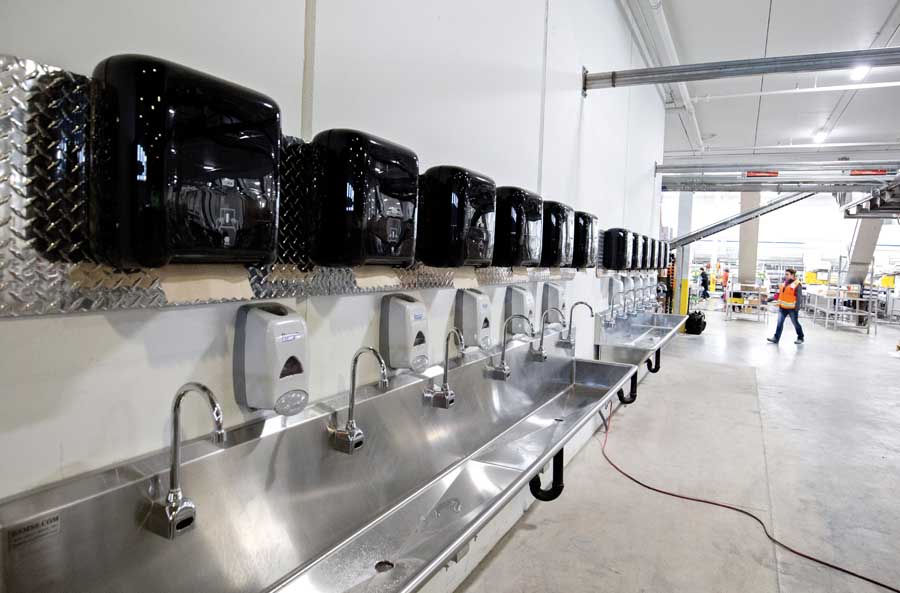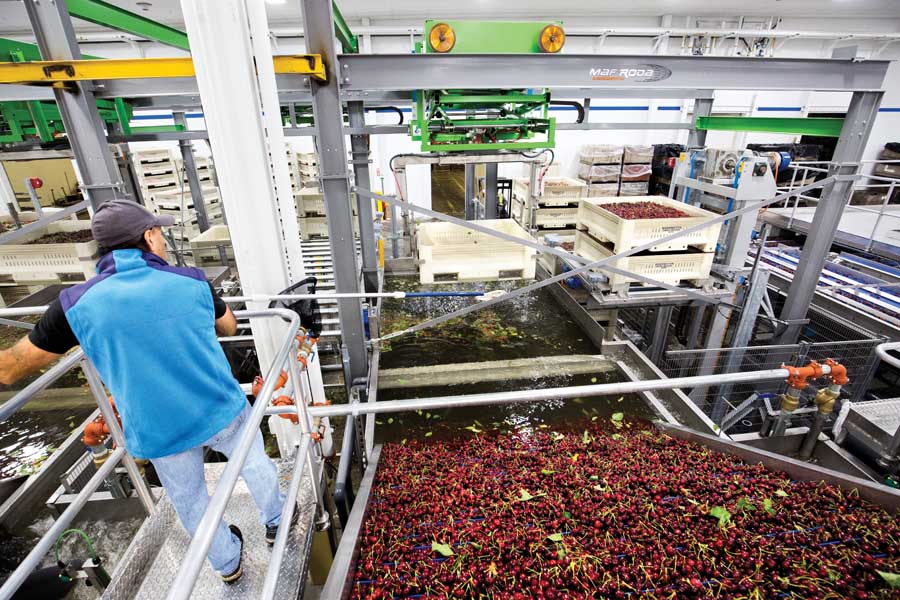
Edgar Salar drops boxes down a chute to workers at the new cherry processing facility operated by Blue Bird Inc. during a mid-June packing run in Wenatchee, Washington. The facility replaces a $10 million facility destroyed by a 2015 wildfire. (TJ Mullinax/Good Fruit Grower)
Eleven months to the day after a wildfire destroyed a packing house in central Washington, one of the Northwest’s oldest grower cooperatives reopened to cherry packing there with a new line that is bigger and more sophisticated than the one it lost.
That speaks to the speed at which new technologies are coming to market on the packing side of the tree fruit industry — the $10 million line that burned was brand new — as well as the need to rebuild quickly to meet industry demand.
The new cherry line includes a total of 42 lanes with three parallel sizers and 54 drops, up from the previous line with 28 lanes and 32 drops.
In addition, one of the sizers is 12 drops longer than the other two, which enables Blue Bird Inc. to pack organic cherries or Rainiers simultaneously with other varieties.
An increased consumer packaging area allows the cooperative to pack greater volumes of clamshells, as well as the new pouch bag style.
The system includes both automated and manual filling stations, and Blue Bird is employing 22 fewer workers — who are running more fruit — than last year.

Blue Bird’s new facility can accommodate several styles of commercial packaging for cherries, like clamshells and pouches at their Wenatchee, Washington location on June 13, 2016. (TJ Mullinax/Good Fruit Grower)
The optical system is processing the digital images from the cameras three times faster than last year as well.
“We hope to continue to evaluate our labor and reduce as needed,” President Ron Gonsalves said. “Already, though, we’re seeing this system is allowing us to diversify in ways we couldn’t before.”
The capacity of the new line, under optimum conditions: 10 tons per hour on each sizer, for a combined 30 tons per hour if all 42 lanes are in use.
Overall, Blue Bird expects to pack 13,000 tons this year.
A quick recovery
Last summer, embers from a nearby wildfire sparked a blaze at a neighboring warehouse in the industrial district of Wenatchee, Washington. The fire, pushed by high winds, quickly spread.
By the time firefighters doused it, Blue Bird had lost its new cherry line, as well as a dedicated organic line of 15 years and 75,000 cartons of packed fruit. Firefighters saved the storage warehouses, including rack storage and a 12-room CA storage building.
Blue Bird never questioned rebuilding; the co-op invested $4.5 million in storage at the Wenatchee site in 2011. Blue Bird has 193 grower members and owns another 750 acres of pears and apples itself, 75 percent of which are certified organic, and another packing house for apples and pears at its corporate headquarters in nearby Peshastin.
The company started packing again in Wenatchee on May 27. “Of course, Mother Nature did nothing to help us out this year by being the earliest year ever,” Gonsalves said with a smile. “She had no compassion for us whatsoever, provided us no relief.”
Structurally, the new warehouse underwent significant changes floor to ceiling, from drains that can be easily cleaned and sanitized to a finished drop ceiling through the production area.
The facility is larger — 120,000 square feet to 105,000 square feet — with the same footprint but more space in an added mezzanine. Lighting is 100 percent LED, and Blue Bird also installed 72 solar tubes and multiple large windows to bring in supplemental natural light.
The design eliminated forklift traffic in the packing room itself, other than in the dumping area, to improve worker safety and reduce food safety concerns. Elevated catwalks minimize the number of visitors on the packing floor, “which also plays into food safety requirements,” Gonsalves said.
The centrally located mezzanine separates the cherry line and a new apple line, scheduled to be completed by mid-August. Shared restrooms, washing stations and a lunchroom sit underneath.

Employee washing stations and restrooms are centrally located between the cherry processing facility and future apple processing facility. (TJ Mullinax/Good Fruit Grower)
The co-op fully integrated its fire system, with lights, red strobes, sirens and sprinklers, for the entire building, and there is direct access to water on the roof.
Blue Bird also installed two-hour rated, fire-resistant board between the building’s insulation and membranes, a step intended to buy additional time if firefighters are delayed in the event of a future fire.
“That board may have protected us from losing the building before had it been up there,” Gonsalves said. “Of course, we’re taking all these precautions, and you typically say, ‘We’ll never have a fire,’ but we never thought the Wenatchee facility was susceptible to fire in the past. Not located in the middle of town.”
Equipment upgrades

Angel Gallegos scoops out stems and leaves from a robotic cherry submersible dumper. (TJ Mullinax/Good Fruit Grower)
Cherries enter the line through twin-feed, robotic submersible dumpers. All of the equipment on the lines is stainless steel or aluminum for sanitary purposes.
Each of the three sizing lanes features three cameras on each side of the lane for optical sizing, defect sorting and measuring internal firmness. Each camera takes 10 pictures, resulting in 60 pictures per cherry in just a fraction of a second.
There also are more options for defect and color sorting: dark and light, finding scars, stemless and doubles, sorting for shape and softness, said Ralph Deleon, who has worked for manufacturer MAF for 17 years and is stationed at Blue Bird as the co-op works with the new equipment.
“The software has more capabilities, higher definition of the photos of the fruit,” he said.
A hydro-cooling unit holds 200 tons of refrigeration, and a smaller, independent unit with a separate water source serves the longer line that can pack organic or conventional fruit. Another tank contains 100 percent ozonized water from an onsite ozone generator for the last fruit treatment before fruit is packed into the different style cartons.
“Typically, the industry is either treating with food grade fungicides of different sorts, but we’ve eliminated all of the fungicides and ozone is working well,” Gonsalves said. “We ship all across the country, all around the world, and residual components, MRLs, are playing into our treatment with ozone. And right now, we’re satisfied with the effectiveness of it.”
A six-lane apple line lost in the fire is being replaced by an eight-lane MAF line, with upgraded defect sorting and sanitation technologies. A robotic stacker grabs each bin, weighs it and then pressure-washes the feet of the bin and the skid before dumping the fruit.
The bin then is pressure-washed again, inside and out, and re-nested into a stack of three, all before leaving the warehouse and returning to the field.
“This is a technology that’s used in a lot of facilities in Europe, but this is one of the first installations here that has fully integrated bin washing on the line itself,” Gonsalves said. “We’re pretty excited about getting that online.” •
– by Shannon Dininny






Leave A Comment